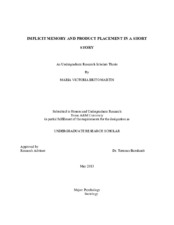| dc.description.abstract | Product placement is rising in popularity as a marketing technique that allows companies to expose consumers to their brand by inserting their products in media like music, television, and print. This study explores implicit memory for products placed in the medium of print. Participants read a short story in which 20 name-brand products were placed. Then, all participants were presented with both a forced choice-purchasing task, and a semantic comparison task. In the forced choice task, a category name was presented at the top of the screen and two alternative product pictures of the same category type (i.e., two beers) were provided at the bottom where subjects picked the product they would purchase at the store. While in the semantic comparison task, three product pictures were presented and subjects were told that the cue product at the top could be matched to either product on the bottom depending on the verbal dimension cue presented in the center. The order of these test tasks was counterbalanced across participants. The results indicated there was no influence of product placement in the story on performance in the first test task, regardless of whether it was forced choice or semantic comparison. However, when forced choice was second, forced choice decisions were significantly faster on trials that included a product that had been placed in the story and had then also been seen in the semantic comparison task. It was argued that the sequence of cognitive processes instated by the sequence of tasks in this experiment – namely, processing the individual dimensions of a particular product (as in the semantic comparison task) and then deciding amongst products in a particular category (as in the forced choice task) – duplicates the sequence of cognitive processes in which buyers engage every day. As such, the semantic comparison task may provide a new direction for successful marketing techniques. | en |


